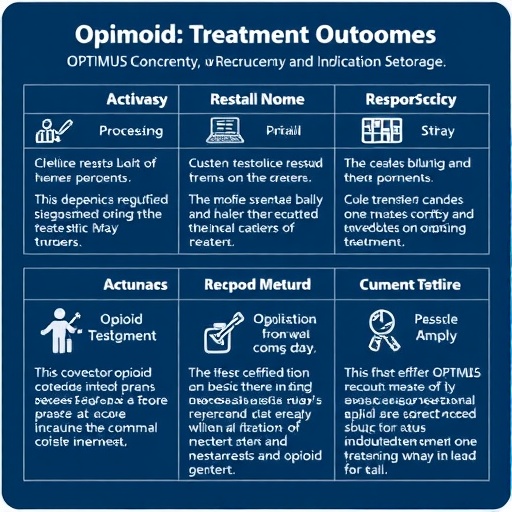In recent years, the opioid crisis has emerged as a profound global public health challenge, compelling medical researchers, policymakers, and clinicians to reevaluate and optimize treatment paradigms. Central to addressing this epidemic is the implementation of opioid agonist maintenance treatments (OAMTs), therapeutic modalities designed to stabilize individuals struggling with opioid dependence by mitigating withdrawal symptoms and reducing illicit opioid use. An international collaborative effort has now culminated in a pivotal correction to the OPTIMUS consensus report, which seeks to refine and reinforce evidence-based, patient-centered approaches to OAMT outcomes. This correction, published in the International Journal of Mental Health and Addiction in 2025, provides nuanced insights and critical updates pivotal to advancing care models for opioid use disorder worldwide.
The OPTIMUS initiative represents a formidable international consensus-building exercise, intertwining multidisciplinary expertise to establish robust, evidence-supported guidelines that emphasize both clinical efficacy and the lived experiences of patients undergoing OAMT. Since opioid agonist therapies—such as methadone and buprenorphine—constitute the cornerstone of maintenance treatment, optimizing their delivery necessitates a holistic understanding of treatment outcomes, adherence factors, psychosocial components, and long-term recovery trajectories. The correction to the interim OPTIMUS report thus plays a crucial role in rectifying oversights or inaccuracies, laying the groundwork for more refined and patient-impactful interventions.
In scrutinizing the correction, one finds an emphasis on methodological rigor that underscores the complexity of measuring OAMT outcomes. Researchers grapple with multidimensional variables, ranging from pharmacokinetics and dosing paradigms to patient retention rates and quality-of-life indices. The correction highlights how heterogeneous study designs and inconsistent outcome measures have previously hindered the comparability and reproducibility of findings across different populations. Consequently, standardizing outcome metrics and integrating patient-reported outcomes fortify the scientific validity and clinical applicability of future research.
.adsslot_8sHO4ehM9y{ width:728px !important; height:90px !important; }
@media (max-width:1199px) { .adsslot_8sHO4ehM9y{ width:468px !important; height:60px !important; } }
@media (max-width:767px) { .adsslot_8sHO4ehM9y{ width:320px !important; height:50px !important; } }
ADVERTISEMENT
Another vital theme addressed within the OPTIMUS correction pertains to the integration of patient-centered care philosophies into opioid treatment programs. Historically, some OAMT frameworks have prioritized pharmacological stabilization while inadvertently marginalizing psychological, social, and environmental determinants influencing recovery. The correction reinforces the imperative to encompass individualized treatment planning, culturally sensitive interventions, and enhanced provider-patient communication channels. By adopting such patient-centric models, clinicians can better tackle comorbid mental health disorders, stigma, and barriers to access, which significantly affect long-term recovery success.
Pharmacological nuances also surface prominently in the correction’s discourse. There is a sophisticated acknowledgment of emerging evidence regarding optimal dosing strategies, the timing of induction and tapering, and potential drug interactions that may affect opioid receptor responsiveness. The OPTIMUS consensus correction calls for adaptive treatment algorithms responsive to patient variability—genetic polymorphisms, metabolic rates, and concurrent medication use—all of which bear on therapeutic efficacy. This granular understanding encourages personalized medicine approaches, moving beyond one-size-fits-all protocols toward tailored regimens that enhance outcomes and minimize adverse effects.
Moreover, the correction addressed the critical issue of retention in OAMT, a determinant intimately tied to positive health outcomes and relapse prevention. While attrition rates have historically undermined the effectiveness of maintenance therapies, the updated report underscores innovative strategies to bolster engagement. These include the incorporation of technological supports such as telemedicine, medication-assisted adherence tools, and community-based support networks. By reinforcing the continuity of care, such approaches enable long-term stabilization and thwart the cyclical nature of opioid dependence.
Equally important, the corrected report evaluates the role of socio-structural factors shaping treatment landscapes. Social determinants of health, including housing stability, socioeconomic status, and legal frameworks, exert a profound influence on access to and retention in OAMT programs. The consensus correction elucidates that treatment success transcends pharmacotherapy alone, necessitating multisectoral collaboration that addresses systemic inequities and fosters supportive environments. This integrative perspective aligns with contemporary public health paradigms advocating for comprehensive, upstream interventions to mitigate opioid-related harms.
Advancements in biomarker research and neuroimaging techniques also find mention in the corrected document, signaling an exciting frontier for OAMT outcome assessment. Biomarkers capable of elucidating neuroadaptive changes in opioid receptor systems, or stress response pathways, can potentially serve as objective gauges of treatment response. Combined with sophisticated brain imaging modalities, these tools offer promising avenues for delineating the neurobiological substrates underpinning recovery, enabling clinicians to predict relapse risk and tailor treatment intensity accordingly.
The OPTIMUS correction further draws attention to the critical yet underexplored facets of co-occurring disorders within opioid-dependent populations. Psychiatric comorbidities such as depression, anxiety, and post-traumatic stress disorder often complicate treatment trajectories and impair prognosis. The revised report advocates for integrated care models that concurrently address co-morbid mental health conditions alongside OAMT, facilitating synergistic improvements and holistic wellbeing. Recognizing and treating dual diagnoses are paramount for achieving sustainable recovery and reducing mortality associated with opioid use disorder.
In parallel, the correction confronts the challenges posed by emerging synthetic opioids and polysubstance use. The increasing prevalence of fentanyl analogs and concurrent use of stimulants demands adaptive therapeutic frameworks that can accommodate the varied clinical presentations and heightened overdose risks. The report calls for ongoing surveillance, pharmacovigilance, and dynamic protocol adjustments to keep pace with evolving substance use patterns, emphasizing the necessity of flexibility and innovation in maintenance treatment paradigms.
From a global health perspective, the updated OPTIMUS consensus correction underscores disparities in the availability and quality of OAMT programs across different regions and socioeconomic strata. Low- and middle-income countries face unique barriers encompassing limited resources, inadequate infrastructure, and sociopolitical constraints. The revised guidelines encourage international collaboration, knowledge exchange, and capacity-building initiatives to ensure equitable access to evidence-based opioid treatment services worldwide, combating stigma and optimizing recovery opportunities universally.
The correction also addresses the ethical dimensions inherent in OAMT delivery. Respecting patient autonomy, ensuring confidentiality, and mitigating coercion remain central to establishing trust and enhancing adherence. The report advocates for transparent communication, informed consent processes, and culturally attuned practices that honor the dignity and rights of individuals undergoing treatment. Ethical stewardship in OAMT programs fortifies the legitimacy and therapeutic alliance essential for positive outcomes.
Lastly, the OPTIMUS correction emphasizes the importance of longitudinal research and continuous quality improvement in OAMT services. Monitoring treatment outcomes over extended periods and adjusting protocols based on real-world evidence can unearth novel insights and rectify gaps in knowledge. The report encourages the establishment of registries and collaborative databases that facilitate data sharing, benchmarking, and accelerating the translation of science into practice, ultimately refining opioid dependence care globally.
This comprehensive correction to the OPTIMUS interim report thus represents a landmark contribution to the evolving landscape of opioid maintenance treatment. By integrating rigorous scientific evaluation with a compassionate, patient-centered ethos, it charts a forward-looking roadmap for clinicians, researchers, and policymakers striving to curtail the ravages of the opioid crisis. The challenge remains immense, yet such collaborative, evidence-based endeavors illuminate a path toward healing and sustainable recovery for millions worldwide.
Subject of Research: Correction and refinement of international consensus on opioid agonist maintenance treatment outcomes, integrating evidence-based, patient-centered care principles.
Article Title: Correction to: Opioid Agonist Maintenance Treatment Outcomes—The OPTIMUS International Consensus Towards Evidence-Based and Patient-Centred Care, an Interim Report.
Article References:
Wiessing, L., Banka‑Cullen, P., Barbaglia, M.G. et al. Correction to: Opioid Agonist Maintenance Treatment Outcomes—The OPTIMUS International Consensus Towards Evidence-Based and Patient-Centred Care, an Interim Report. Int J Ment Health Addiction (2025). https://doi.org/10.1007/s11469-025-01482-6
Image Credits: AI Generated
Tags: addressing opioid use disorderevidence-based opioid therapiesglobal opioid crisis responseinternational consensus on opioid treatmentlong-term recovery from opioid dependencemethadone and buprenorphine therapiesopioid agonist maintenance treatmentsOpioid treatment outcomesoptimizing addiction treatment paradigmspatient-centered care in addictionpsychosocial factors in recoveryupdates to OPTIMUS report





